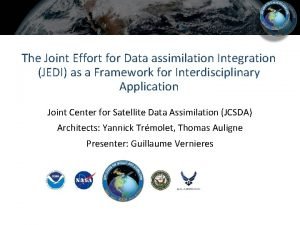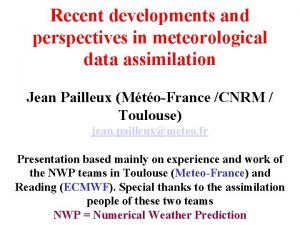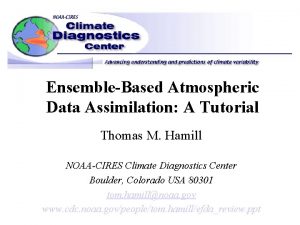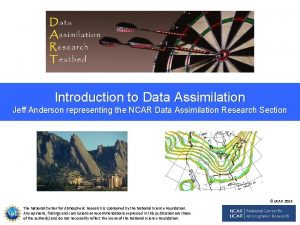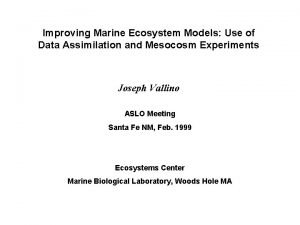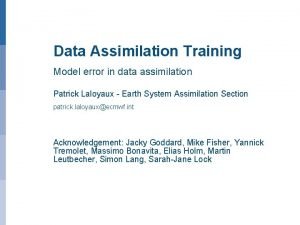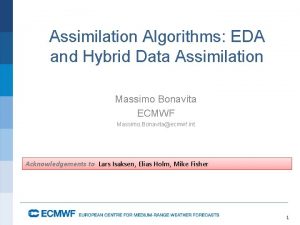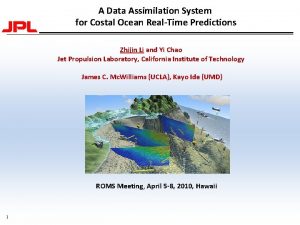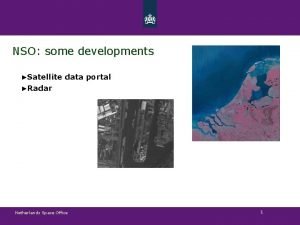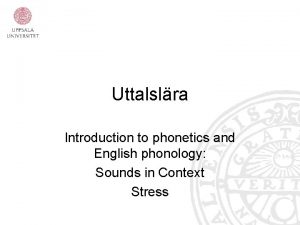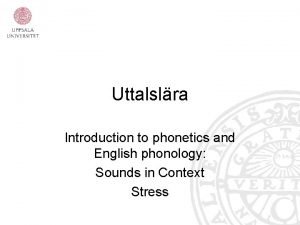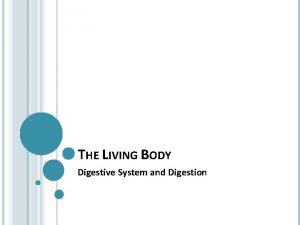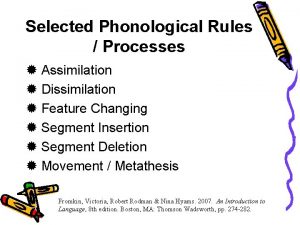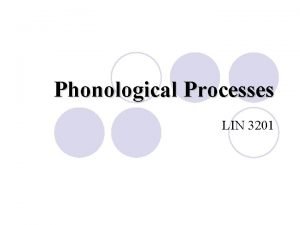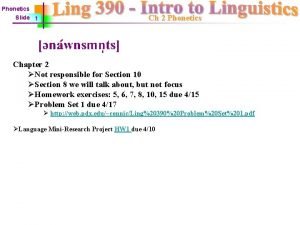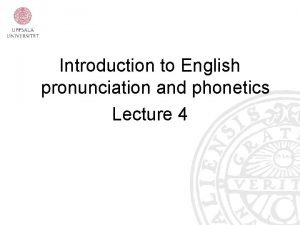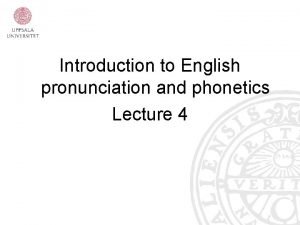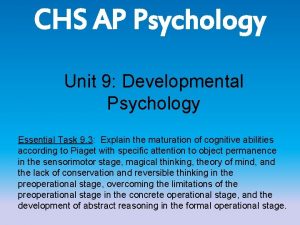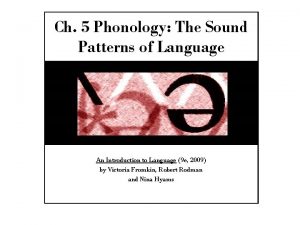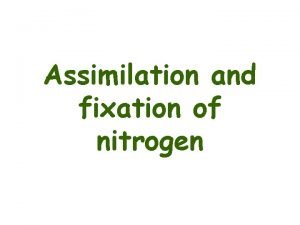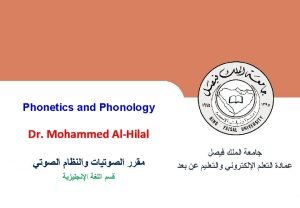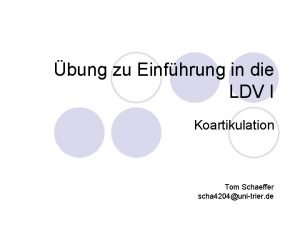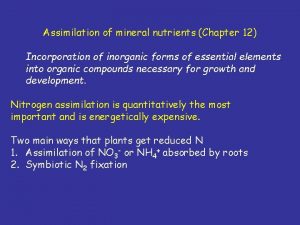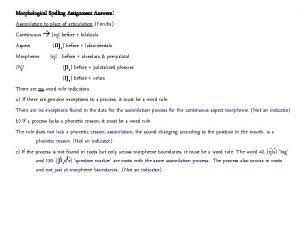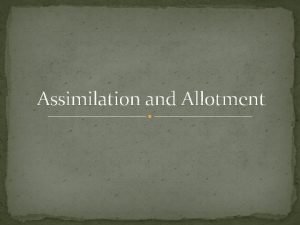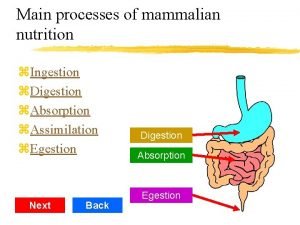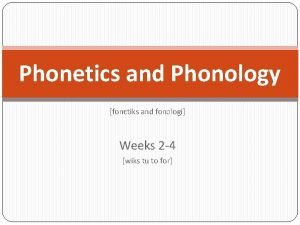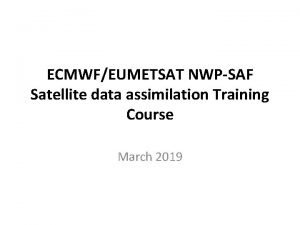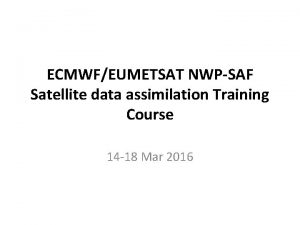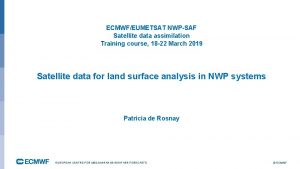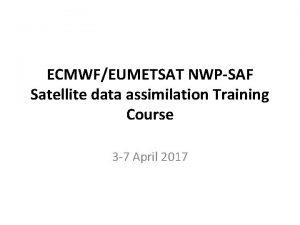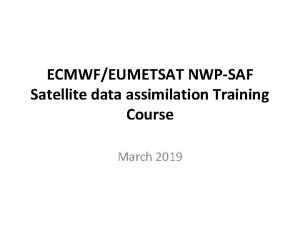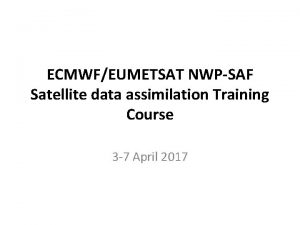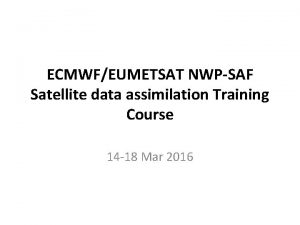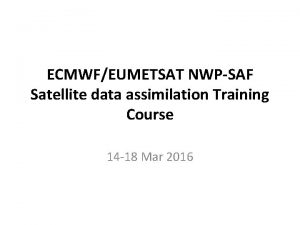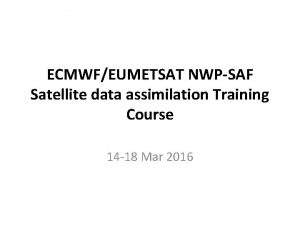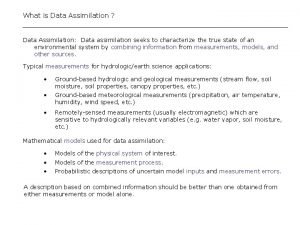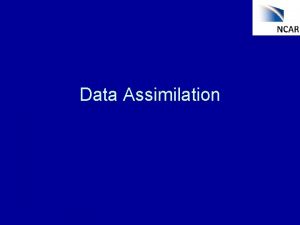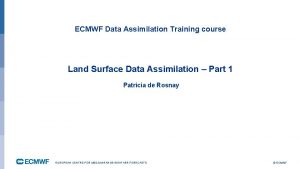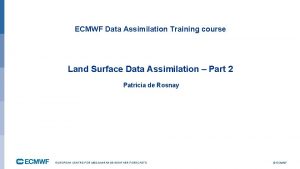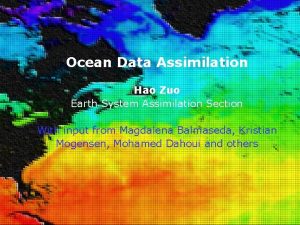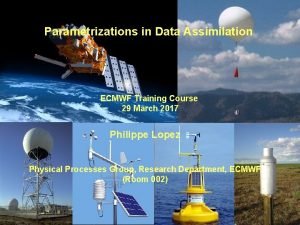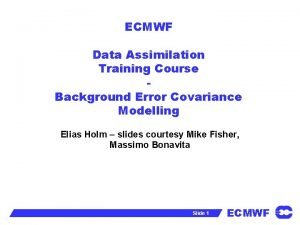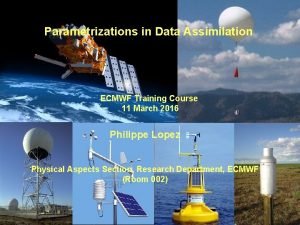ECMWFEUMETSAT NWPSAF Satellite data assimilation Training course 14















































- Slides: 47

ECMWF/EUMETSAT NWP-SAF Satellite data assimilation Training course, 14 -18 March 2015 Use of satellite data for land surface analysis Patricia de Rosnay EUROPEAN CENTRE FOR MEDIUM-RANGE WEATHER FORECASTS © ECMWF

Introduction: Land Surfaces in Numerical Weather Prediction (NWP) • Processes: Continental hydrological cycle, interaction with the atmosphere on various time and spatial scales • Boundary conditions at the lowest level of the atmosphere • Crucial for near surface weather conditions, whose high quality forecast is a key objective in NWP Land surface processes modelling & initialisation are important for NWP at all range (short to seasonal) Trenberth et al. J. Hydrometeorol. , 2007 (Beljaars et al. , Mon. Wea. Rev, 1996, Koster et al. , Science 2004, Koster et al. J Hydrometeorol. 2011) EUROPEAN CENTRE FOR MEDIUM-RANGE WEATHER FORECASTS © ECMWF

ECMWF Integrated Forecasting System (IFS) (10 -day) Ø Forecast Model: GCM including the H-TESSEL land surface model (fully coupled) Ø Data Assimilation initial conditions of the forecast model prognostic variables - 4 D-Var for atmosphere - Land Data Assimilation System EUROPEAN CENTRE FOR MEDIUM-RANGE WEATHER FORECASTS © ECMWF

ECMWF Integrated Forecasting System (IFS) (10 -day) Ø Forecast Model: GCM including the H-TESSEL land surface model (fully coupled) Ø Data Assimilation initial conditions of the forecast model prognostic variables - 4 D-Var for atmosphere - Land Data Assimilation System Several Systems: Ø NWP (oper): Ø ERA-Interim: Ø ERA 5: Ø ERA-Interim-Land: Ø ERA 5 -Land: IFS (with 4 D-Var and LDAS), 9 km, version 41 r 2 (2016) Weakly coupled DA IFS (with 4 D-Var and LDAS), 79 km, version 31 r 1 (2006) IFS (with 4 D-Var and LDAS), 39 km, version 41 r 2 (2016) 79 km H-TESSEL LSM simulations forced by ERA model only: no LDAS 39 km EUROPEAN CENTRE FOR MEDIUM-RANGE WEATHER FORECASTS © ECMWF

Introduction: Land Surface Data Assimilation (LDAS) Snow depth - Methods: Cressman (DWD, ECMWF ERA-I), 2 D Optimal Interpolation (OI) (ECMWF operational and ERA 5, CMC) - Conventional Observations: in situ snow depth - Satellite data: NOAA/NESDIS IMS Snow Cover Extent (ECMWF), H-SAF snow cover (UKMO in dvpt) Soil Moisture - Methods: -1 D Optimal Interpolation (Météo-France, CMC, ALADIN and HIRLAM) - Simplified Extended Kalman Filter (EKF) (DWD, ECMWF, UKMO) - Conventional observations: Analysed SYNOP 2 m air relative humidity and temperature, from 2 D OI screen level parameters analysis - Satellite data : ASCAT soil moisture (UKMO, ECMWF, KMA), SMOS (dvpt ECMWF, UKMO, Env. Canada) Soil Temperature and Snow temperature - 1 D OI for the first layer of soil and snow temperature (ECMWF, Météo-France) EUROPEAN CENTRE FOR MEDIUM-RANGE WEATHER FORECASTS © ECMWF

Snow in operational forecasting systems Example of the ECMWF system: Snow Model: Component of H-TESSEL ; Single layer snowpack - Snow water equivalent SWE (m), ie snow mass Prognostic - Snow Density ρs variables - Snow Albedo Snow depth (SD) is diagnostic: SD=SWE. w / s with w water density Observations: - Conventional snow depth data: SYNOP and National networks - Snow cover extent: NOAA NESDIS/IMS daily product (4 km) Data Assimilation: - Optimal Interpolation (OI) in operational IFS - Analysed variable: SWE, density EUROPEAN CENTRE FOR MEDIUM-RANGE WEATHER FORECASTS © ECMWF

Snow Observations Interactive Multisensor Snow and Ice Mapping System (IMS) - Time sequenced imagery from geostationary satellites AVHRR, SSM/I Station data NOAA/NESDIS IMS Snow extent data Northern Hemisphere product Daily Polar stereographic projection Information content: Snow/Snow free Data used at ECMWF: - 24 km product (ERA-Interim) - 4 km product (operational NWP, ERA 5) More information at: http: //nsidc. org/data/g 02156. html EUROPEAN CENTRE FOR MEDIUM-RANGE WEATHER FORECASTS IMS Snow Cover 5 Feb. 2014 © ECMWF

Use of NESDIS/IMS snow cover data - IMS snow cover (SC) means SC>50% - But no quantitative information on snow depth - Relation snow cover (SC)/Snow Depth (SD): SC=50% corresponds to SD=5 cm - Previously: direct insertion of 10 cm when IMS has snow & model has no snow - Issues with overestimated snow - IFS revision for current cycle: assimilate IMS and account for IMS observation error Snow No Snow x DA 5 cm No Snow DA NESDIS Fst Guess Use of IMS at ECMWF DA Error specifications: BG: σb SYNOP σSYNOP = 4 cm IMS σims EUROPEAN CENTRE FOR MEDIUM-RANGE WEATHER FORECASTS IMS has snow(SC>=50%) → Model eq depth >= 5 cm Model relation between Snow Cover = 3 cm (SC) and Snow Depth (SD) = 8 cm © ECMWF

Case Study: Normandie 12 -13 March 2013 Analysis 2013 03 13 at 06 UTC Old: Direct insertion Current: DA 500 150 100 70 50 20 15 10 5 2 Improved use of NESDIS/IMS snow cover combined with in situ snow depth Account for NESDIS/IMS errors, better represents snow line. EUROPEAN CENTRE FOR MEDIUM-RANGE WEATHER FORECASTS © ECMWF

Snow analysis: Forecast impact Revised IMS snow cover data assimilation (2013) Impact on snow October 2012 to April 2013 (251 independent in situ observations) Impact on atmospheric forecasts October 2012 to April 2013 (RMSE new-old) Consistent improvement of snow and atmospheric forecasts EUROPEAN CENTRE FOR MEDIUM-RANGE WEATHER FORECASTS de Rosnay et al. , ECMWF NL 143, Spring 2015 © ECMWF

Simplifed EKF soil moisture analysis The simplified EKF is used to corrects the soil moisture trajectory of the Land Surface Model For each grid point, analysed soil moisture state vector θa: θ a= θ b+ K (y-H [θ b]) background soil moisture state vector, non linear observation operator observation vector Kalman gain matrix, fn of H (linearsation of H), B and R (covariance matrices of background and observation errors). θ H y K Used at ECMWF (operations and ERA 5), DWD, UKMO Observations used at ECMWF: For operational NWP: • Conventional SYNOP pseudo observations (analysed T 2 m, RH 2 m) • Satellite Met. Op-A/B ASCAT soil moisture Research: SMOS Data Assimilation Drusch et al. , GRL, 2009 de Rosnay et al. , ECMWF News Letter 127, 2011 de Rosnay et al. , QJRMS, 2013 EUROPEAN CENTRE FOR MEDIUM-RANGE WEATHER FORECASTS © ECMWF

Satellite data for NWP soil moisture analysis Active microwave data: ASCAT: Advanced Scatterometer On Met. OP-A (2006 -), Met. OP-B (2012 -) C-band (5. 6 GHz) NRT Surface soil moisture Operational product ensured operational continuity Passive microwave data: SMOS: Soil Moisture & Ocean Salinity L-band (1. 4 GHz) NRT Brightness Temperature Dedicated soil moisture mission Strongest sensitivity to soil moisture Active and Passive: SMAP: Soil Moisture Active Passive L-band TB 2015 Dedicated soil moisture mission Operational Monitoring of surface soil moisture related satellite data: ASCAT soil moisture (m 3 m-3) SMOS Brightness temperature (K) Stdev FG_depar Sept. 2013 EUROPEAN CENTRE FOR MEDIUM-RANGE WEATHER FORECASTS © ECMWF

Passive microwave remote sensing Soil Moisture and Ocean Salinity mission SMOS ESA Earth Explorer mission (2009 -present) L-band (1. 4 GHz) instrument. Optimal frequency for soil moisture remote sensing Sun-synchronous, quasi-circular orbit at altitude 758 km. 06. 00 hrs local solar time at ascending node. Three days revisit at Equator Dual polarisation: H and V in the Earth reference, xx and yy in the antenna frame reference Multi-angular measurements 0 to 60° ECMWF and CMC: use NRT SMOS Brightness Temperature (TB) data Use observation operator to simulate L-band TB: Community Microwave Emission Modelling Platform (CMEM) EUROPEAN CENTRE FOR MEDIUM-RANGE WEATHER FORECASTS © ECMWF

Microwave emission modelling • Forward operator: microwave emission model • ECMWF Community Microwave Emission Modelling Platform (CMEM) • I/O interfaces for the Numerical Weather Prediction Community. https: //software. ecmwf. int/wiki/display/LDAS/CMEM Also used at CMC, CSIRO, GSFC, and others centres Current version 5. 0 (July 2015) References: Drusch et al. JHM, 2009 de Rosnay et al. JGR, 2009 de Rosnay, ESA Report, 2009 EUROPEAN CENTRE FOR MEDIUM-RANGE WEATHER FORECASTS © ECMWF

CMEM Simulations of L-Band Brightness Temperature (TB) ECMWF TB July 2010 TOA TBH Global ECMWF TB Land only and after QC (remove areas with snow, frozen conditions and orography) EUROPEAN CENTRE FOR MEDIUM-RANGE WEATHER FORECASTS © ECMWF

SMOS Bias correction (BC) Cumulative Distribution Function CDF-matching matches mean and variance of two distributions. TBSMOS* = a + b TBSMOS with a = TBECMWF – TBSMOS (σECMWF /σSMOS ) b = σECMWF / σSMOS Matching parameters on each grid point for each month - Based on ECMWF re-analysis: CMEM forward TB a - Long term data sets: January 2010 – March 2014 - Computed at 40 km resolution (SMOS resolution) - Monthly CDF: 3 -month moving window b - Multi-angular and dual polarisation CDF EUROPEAN CENTRE FOR MEDIUM-RANGE WEATHER FORECASTS © ECMWF

SMOS forward operator and Bias correction Jul 2012 Comparison between SMOS and ECMWF TB: First Guess departure statistics St Dev 19 K RMSE (K) Before BC St Dev 8 K RMSE (K) after BC EUROPEAN CENTRE FOR MEDIUM-RANGE WEATHER FORECASTS © ECMWF

SMOS forward operator and Bias correction Correlation (2012) TBxx 40 degrees Before SMOS BC (0. 52) After SMOS BC (0. 57) Monthly CDF-matching → improves correlation EUROPEAN CENTRE FOR MEDIUM-RANGE WEATHER FORECASTS © ECMWF

Comparison between SMOS and ECMWF TB Long term comparison between: - SMOS NRT TB (proc v 505 reprocessed and NRT data sets) and - ECMWF-CMEM re-analysis using latest physiographic data base (IFS CY 41 R 1). RMSE (K) R Anomaly R 2010 8. 68 0. 545 0. 277 2011 8. 03 0. 565 0. 285 2012 7. 78 0. 567 0. 302 2013 7. 40 0. 595 0. 315 Table: Global mean statistics, after bias correction, considering xx and yy pol at 30, 40, 50 degrees incidence angles. Consistent improvement of agreement between SMOS and ECMWF reanalysis from 2010 to 2013 EUROPEAN CENTRE FOR MEDIUM-RANGE WEATHER FORECASTS © ECMWF

SMOS Forward modelling and Bias correction • CMEM: ECMWF Community Microwave Emission Modelling Platform produce reprocessed ECMWF SMOS TB for 2010 -2013 • Comparison between ECMWF TB and SMOS NRT TB (both reprocessed) • Consistent improvement of SMOS data at Pol xx and yy, for incidence angles 30, 40, 50 degrees de Rosnay et al, in prep Anomaly correlation RMSE Polarisation (xx or yy) and incidence angle (30, 40, 50) EUROPEAN CENTRE FOR MEDIUM-RANGE WEATHER FORECASTS © ECMWF

SMOS Monitoring Near real time (NRT) monitoring of SMOS TB at ECMWF (Muñoz Sabater et al. ECMWF Newsletter & IEEE TGRS 2011) RFI (Radio Frequency Interference) sources impact on FG departures (Obs-model) : large standard deviation (St. Dev); Lots of RFI sources switched off in Europe, new sources identified in 2012, major issue in Asia. St. Dev first guess departure (Obs-Model) In Kelvin for Jan-Feb 2013 EUROPEAN CENTRE FOR MEDIUM-RANGE WEATHER FORECASTS © ECMWF

Satellite data for NWP soil moisture analysis Active microwave data: ASCAT: Advanced Scatterometer On Met. OP-A (2006 -), Met. OP-B (2012 -) C-band (5. 6 GHz) NRT Surface soil moisture Operational product ensured operational continuity Passive microwave data: SMOS: Soil Moisture & Ocean Salinity L-band (1. 4 GHz) NRT Brightness Temperature Dedicated soil moisture mission Strongest sensitivity to soil moisture Active and Passive: SMAP : Soil Moisture Active Passive L-band TB 2015 Dedicated soil moisture mission Operational Monitoring of surface soil moisture related satellite data: ASCAT soil moisture (m 3 m-3) SMOS Brightness temperature (K) Stdev FG_depar Sept. 2013 EUROPEAN CENTRE FOR MEDIUM-RANGE WEATHER FORECASTS © ECMWF

ASCAT soil moisture - ASCAT is a soil moisture index (0 -1) ; models soil moisture variable is a volumetric quantity (m 3 m-3) - Systematic differences between model and observations - Data assimilation aims at correcting for the model random errors, so a bias correction method is necessary to match the observations ‘climatology’ to that of the model ( See D. Dee’s Lecture on Bias Correction) For soil moisture data assimilation systems simplified Bias correction method often used Cumulative Distribution Function Matching: CDF-Matching (e. g. Scipal et al. WRR 2008, Draper et al, JGR 2009) ECMWF: Revised in 2011 to account for seasonal cycle (de Rosnay et al. , ECMWF Res. Memo. 2011) EUROPEAN CENTRE FOR MEDIUM-RANGE WEATHER FORECASTS © ECMWF

ASCAT Bias Correction (CDF matching) - ASCAT soil moisture index ms. ASCAT - Model soil moisture θ (m 3/m-3) Simple Cumulative Distribution Function (CDF) matching (Scipal et al. , 2008) θascat = a + b msascat with a = θmodel – msascat (σmodel /σms_ascat ) b = σmodel / σms_ascat Matches mean and variance a and b are CDF matching parameters computed on each model grid point ASCAT CDF-matching has two objectives: ASCAT index converted to model equivalent volumetric soil moisture Bias correction EUROPEAN CENTRE FOR MEDIUM-RANGE WEATHER FORECASTS ASCAT matching parameters (de Rosnay et al. , ECMWF Res memo R 43. 8/Pd. R/11100, 2011) © ECMWF

ASCAT Bias Correction (CDF matching) Efficient data assimilation relies on accurate bias correction ASCAT index ECMWF model soil moisture (ASCAT old BC) ASCAT with static BC ASCAT with dynamic (seasonal) BC EUROPEAN CENTRE FOR MEDIUM-RANGE WEATHER FORECASTS © ECMWF

ASCAT-A and ASCAT-B ASCAT SM – Model (First guess departure, m 3. m-3) 23 -24 Nov 2012 Metop-A launched in 2006 Metop-B launched in 2012 Consistent ASCAT-A and ASCAT-B soil moisture Departure statistics: ASCAT-A Nb ASCAT-B Mean Std m 3. m-3 ASCAT-A 64893 0. 0152 0. 0645 ASCAT-B 65527 0. 0149 0. 0663 Operational monitoring: http: //www. ecmwf. int/en/forecasts/quality-ourforecasts/monitoring/soil-moisture-monitoring EUROPEAN CENTRE FOR MEDIUM-RANGE WEATHER FORECASTS © ECMWF

ASCAT Soil Moisture data assimilation for NWP Innovation (Obs- model) 25 -30 June 2013 Accumulated Increments (m 3/m 3) in top soil layer (0 -7 cm) ASCAT (m 3/m 3) Due to ASCAT RH 2 m (%) T 2 m (K) Due to SYNOP T 2 m and RH 2 m EUROPEAN CENTRE FOR MEDIUM-RANGE WEATHER FORECASTS © ECMWF

ASCAT Soil Moisture data assimilation for NWP Volumetric Soil Moisture increments (m 3/m 3) (accumulated) 25 -30 June 2013 Vertically integrated Soil Moisture increments (st. Dev in mm) Layer 1 (0 -7 cm) SYNOP ASCAT Layer 1 0. 68 1. 43 Layer 2 1. 48 0. 68 Layer 3 4. 28 0. 46 ASCAT more increments than SYNOP at surface SYNOP give more increments at depth For 12 h DA window, link obs to root zone stronger for T 2 m, RH 2 m than for surface soil moisture observations Layer 2 (7 -28 cm) EUROPEAN CENTRE FOR MEDIUM-RANGE WEATHER FORECASTS © ECMWF

Root Zone Soil Moisture Retrieval Satellite data Surface information Top soil moisture sampling depth: 0 -2 cm ASCAT, 0 -5 cm SMOS Soil Moisture Vertical Profile Root Zone SM Profile Variable of interest for Soil-Plant-Atm interaction, Climate, NWP and hydrological applications Accurate retrieval requires to account for physical processes d 1 0 d 2 d 3 d 4 Soil Moist m 3/m 3 x 100 15 Retrieval of root zone soil moisture using satellite data requires data assimilation approaches EUROPEAN CENTRE FOR MEDIUM-RANGE WEATHER FORECASTS © ECMWF

ASCAT root zone retrieval based on data assimilation EUMETSAT Hydrology SAF ECMWF Atmospheric conditions SYNOP T 2 m RH 2 m analysis ASCAT Surface SM Bias corrected SEKF Soil Moisture Analysis Quality Control use data when: - Topographic complexity ≤ 20 - Wetland Fraction ≤ 15 - Noise level ≤ 8 - processing flag=0 EUROPEAN CENTRE FOR MEDIUM-RANGE WEATHER FORECASTS ASCAT Root Zone product (SM-DAS-2) Analysed root zone soil moisture on model levels 4 layers: 0 -7 cm 7 -28 cm 28 -100 cm 100 -289 cm © ECMWF

ASCAT root zone retrieval based on data assimilation Assimilated ASCAT Surface (0 -7 cm) soil moisture index (0 -1) 04 Sept 2012 00 UTC ASCAT Root Zone Soil Moisture Product (H-SAF SM-DAS-2): Data assimilation used to propagate in space and time the ASCAT surface swath soil moisture information - Daily Soil Moisture product valid at 00: 00 UTC - Daily Global coverage SM-DAS-2: Operational H-SAF since July 2012; Contact: hsafcdop@meteoam. it EUROPEAN CENTRE FOR MEDIUM-RANGE WEATHER FORECASTS © ECMWF

ASCAT root zone retrieval based on data assimilation SM-DAS-2 available on 4 soil layers Assimilated ASCAT soil moisture index (0 -1) 04 Sept 2012 00 UTC Layer 1 (0 -7 cm) Layer 2 (7 -28 cm) EUROPEAN CENTRE FOR MEDIUM-RANGE WEATHER FORECASTS © ECMWF

ASCAT root zone retrieval based on data assimilation SM-DAS-2 available on 4 soil layers Assimilated ASCAT soil moisture index (0 -1) 04 Sept 2012 00 UTC Layer 3 (28 -100 cm) Layer 4 (100 -289 cm) EUROPEAN CENTRE FOR MEDIUM-RANGE WEATHER FORECASTS © ECMWF

Soil moisture Validation Scatterometer root zone soil moisture based on data assimilation Albergel et al. Evaluation of SM-DAS-2/H 14 Surface and root zone liquid soil moisture content OR_2014 OR_2013 OR_2015 Observation (5 cm) SM-DAS-2 (0 -7 cm) Accuracy requirements for product SM-DAS-2 [R] Unit Threshold Target Optimal Dimensionless 0. 50 0. 65 0. 80 © ECMWF

Validation with in situ soil moisture data ASCAT 406 stations from 10 networks SMOS International Soil Moisture Network Validation for 2012 of ASCAT, SMOS and SM-DAS-2 For each station, time series are compared Updated after Albergel et al. Remote Sens Env. 2012 EUROPEAN CENTRE FOR MEDIUM-RANGE WEATHER FORECASTS © ECMWF

Validation with in situ soil moisture data USCRN soil moisture network SM-DAS-2 ASCAT Correlation [-] (for stations with significant values) SMOS EUROPEAN CENTRE FOR MEDIUM-RANGE WEATHER FORECASTS SM-DAS-2 ASCAT SMOS 0. 67 0. 50 (104 stations) (84 stations) © ECMWF

Validation with in situ soil moisture data Normalized Product (nb stations with significant R) SM-DAS-2 ASCAT SMOS (333) (322) (258) Correlation 0. 68 0. 54 Bias (In Situ - Product) -0. 084 -0. 005 0. 027 RMSD 0. 120 0. 110 0. 105 Normalized Product (nb stations with significant R) Correlation on Anomaly Updated after Albergel et al. RSE, 2012 Validation using the 10 Networks Bias and RMSD expressed as soil moisture index (no unit) SM-DAS-2 ASCAT SMOS (310) (291) (234) 0. 56 0. 41 0. 42 - SMOS and ASCAT surface soil moisture have similar quality - Assimilated product (SM-DAS-2) has a larger bias, but in terms of dynamics it shows the best agreement with in situ soil moisture data EUROPEAN CENTRE FOR MEDIUM-RANGE WEATHER FORECASTS © ECMWF

Satellite data for NWP soil moisture analysis Active microwave data: ASCAT: Advanced Scatterometer On Met. OP-A (2006 -), Met. OP-B (2012 -) C-band (5. 6 GHz) NRT Surface soil moisture Operational product ensured operational continuity Passive microwave data: SMOS: Soil Moisture & Ocean Salinity L-band (1. 4 GHz) NRT Brightness Temperature Dedicated soil moisture mission Strongest sensitivity to soil moisture Active and Passive: SMAP: Soil Moisture Active and Passive L-band TB 2015 Dedicated soil moisture mission Operational Monitoring of surface soil moisture related satellite data: ASCAT soil moisture (m 3 m-3) SMOS Brightness temperature (K) Stdev FG_depar Sept. 2013 EUROPEAN CENTRE FOR MEDIUM-RANGE WEATHER FORECASTS © ECMWF

SMAP Launched on 31 Jan 2015 Antenna spin-up end of March First public data distribution in July 2015 EUROPEAN CENTRE FOR MEDIUM-RANGE WEATHER FORECASTS Slide from Dara Entekhabi, ECMWF SMAP Science Team© Lead

SMOS ESA Near-Real-Time soil moisture product: based on Neural Networks NRT designed and evaluated by CESBIO (Centre d’Etudes Spatiales de la Biosphere) (Rodriguez-Fernandez et al. ) Input STD 0. 049 SMOS NRT SM vs SMOS L 3 SM: NN Average temporal correlation = 0. 8 SMOS L 3 0. 064 R 0. 55 0. 50 Bias -0. 024 -0. 026 Average stats vs USDA SCAN in situ measurements better than SMOS L 3 NRT implemented in operations at ECMWF in January 2016, operational ESA March 2016 - A SM product very similar to the current operational one but in Near-Real-Time - ESA product distributed by GTS and EUMETCAST NRT high quality SMOS soil moisture product Very relevant for the scientific community as well as for operational NWP and hydrological forecasts communities © ECMWF

Passive microwave remote sensing Satellite missions relevant for soil moisture: Skylab, NASA, L-band, 1973 -1974 (but only 9 overpasses available) SMMR, Nimbus 7, C-Band (6. 6 GHz) , X-band (10. 7 GHz), 1978 -1987 (Scanning Multichannel Microwave Radiometer) TMI (TRMM Microwave Imager), X-band (10. 7 GHz), 1997 -2014 SSMI (Special Sensor Microwave Imager, DMSP F 8 -13), 19. 3 GHz, 1987 AMSR-E 2002 -2011, (Advanced Scanning Radiometer on Earth Observing System, NASA, C-band (6. 9 GHz) SMOS (Soil Moisture and Ocean Salinity Mission): ESA Earth Explorer, L-band (1. 4 GHz), launched November 2009 First satellite specifically devoted to soil moisture remote sensing AMSR-2 on GCOM-W 1 (Global Change Observation Mission) launched in 2012 SMAP (Soil Moisture Active and Passive), NASA, L-band, launched in January 2015 EUROPEAN CENTRE FOR MEDIUM-RANGE WEATHER FORECASTS © ECMWF

ESA Climate Change Initiative (CCI) Soil moisture: Project overall objective: produce the most complete/consistent global soil moisture data record based on active and passive microwave sensors EUROPEAN CENTRE FOR MEDIUM-RANGE WEATHER FORECASTS http: //www. esa-soilmoisture-cci. org © ECMWF

ESA-CCI SM & ERA-Interim/Land vs. in-situ measurements 2014 (based on daily data) In-situ ESA-CCI-SM ERA-Interim/Land EUROPEAN CENTRE FOR MEDIUM-RANGE WEATHER FORECASTS 10/09/20 4 © ECMWF

Impact of soil vertical resolution for satellite soil moisture H-TESSEL model soil resolution increased: top layer 0 -7 cm replaced by 3 layers 0 -1 cm, 1 -3 cm, 3 -7 cm Anomaly Correlation between ECMWF surface soil moisture and ESA-CCI satellite soil moisture (diff between new-old) (Albergel, Balsamo ) Globally Improved match to satellite soil moisture (shown is ΔACC calculate on 1 -month running mean) Anomaly correlation (1988 -2014) measured with ESA-CCI soil moisture remote sensing (multi-sensor). Provides a global validation of the usefulness of increase soil vertical resolution. EUROPEAN CENTRE FOR MEDIUM-RANGE WEATHER FORECASTS © ECMWF

www. globalfloods. eu Output from global ECMWF NWP land-surface forecast is fed into a routing model (Simplified LISFLOOD (JRC)) to produce flood forecasts – benefiting from all the improvements in the ECMWF Integrated Forecasting System (model and assimilation)! EUROPEAN CENTRE FOR MEDIUM-RANGE WEATHER FORECASTS © ECMWF

Summary and future plans • • Most NWP centres analyse soil moisture and/or snow depth Land Data Assimilation Systems: run separately from the atmospheric 4 D-Var Satellite data used for snow cover and soil moisture analyses Snow analysis: NOAA NESDIS/IMS snow cover data (multi-sensor product). No Snow Water � Equivalent products used for NWP (yet) • Soil moisture: ASCAT operational from April 2015 at ECMWF (also used at UKMO and KMA). SMOS under development (ECMWF, CMC), SMAP • Future plans: SMOS technical test in operational framework • Longer term: Assimilation of integrated hydrological variables such as river discharges: e. g. Surface Water Ocean Topography (SWOT 2020) EUROPEAN CENTRE FOR MEDIUM-RANGE WEATHER FORECASTS © ECMWF

Thank you for your Attention! Useful links: ECMWF LDAS: https: //software. ecmwf. int/wiki/display/LDAS+Home ECMWF SMOS: https: //software. ecmwf. int/wiki/display/LDAS/SMOS ECMWF CMEM: https: //software. ecmwf. int/wiki/display/LDAS/CMEM ECMWF Land Surface Observation monitoring: https: //software. ecmwf. int/wiki/display/LDAS/Land+Surface+Observations+monitoring EUROPEAN CENTRE FOR MEDIUM-RANGE WEATHER FORECASTS © ECMWF
 Jedi data assimilation
Jedi data assimilation Data assimilation
Data assimilation Data assimilation tutorial
Data assimilation tutorial Data assimilation
Data assimilation Data assimilation
Data assimilation Data assimilation
Data assimilation Data assimilation
Data assimilation Data assimilation
Data assimilation Nso.hh
Nso.hh English bond t junction
English bond t junction Course title and course number
Course title and course number Course interne moyenne externe
Course interne moyenne externe Unit 7 cognition ap psychology
Unit 7 cognition ap psychology Regressive assimilation examples
Regressive assimilation examples Stress shift examples
Stress shift examples Regressive assimilation examples
Regressive assimilation examples Examples of carbohydrase
Examples of carbohydrase Example of assimilation in child development
Example of assimilation in child development Dissimilation definition
Dissimilation definition Assimilate vs accommodate
Assimilate vs accommodate Language
Language Complementary distribution examples
Complementary distribution examples Assimilation rules in phonology
Assimilation rules in phonology Phonetic transcription
Phonetic transcription Assimilation linguistics
Assimilation linguistics 4 parts of digestive system
4 parts of digestive system Elision examples phonetics
Elision examples phonetics Strong forms in phonetics
Strong forms in phonetics Schema ap psychology
Schema ap psychology Complementary distribution examples
Complementary distribution examples _____ removes nitrogen from the atmosphere.
_____ removes nitrogen from the atmosphere. Nitrogen assimilation in plants
Nitrogen assimilation in plants Villi adaptation
Villi adaptation Weak form
Weak form Pluralism and assimilation
Pluralism and assimilation Koartikulation
Koartikulation Root name
Root name Assimilation exercises with answers
Assimilation exercises with answers Allotment and assimilation
Allotment and assimilation Celebrate recovery new life church
Celebrate recovery new life church Ingestion digestion absorption assimilation egestion order
Ingestion digestion absorption assimilation egestion order Assimilation westward expansion
Assimilation westward expansion Enculturation vs acculturation
Enculturation vs acculturation Assimilation in science
Assimilation in science Definition of race and ethnicity
Definition of race and ethnicity F
F Examples of allophones
Examples of allophones What is popular culture
What is popular culture
